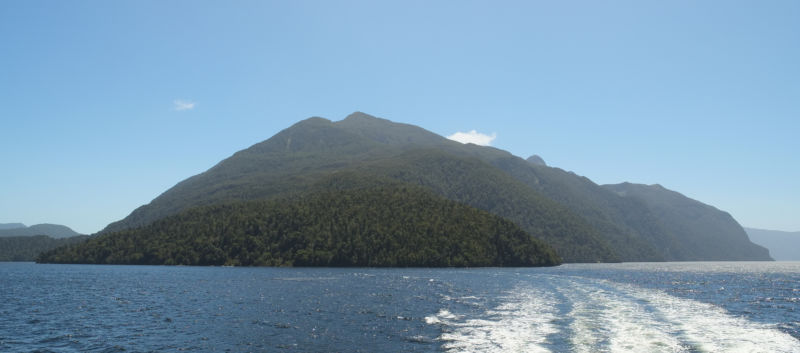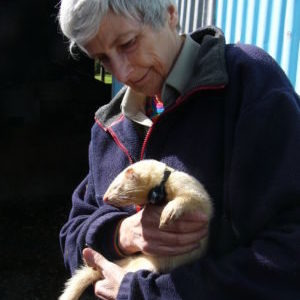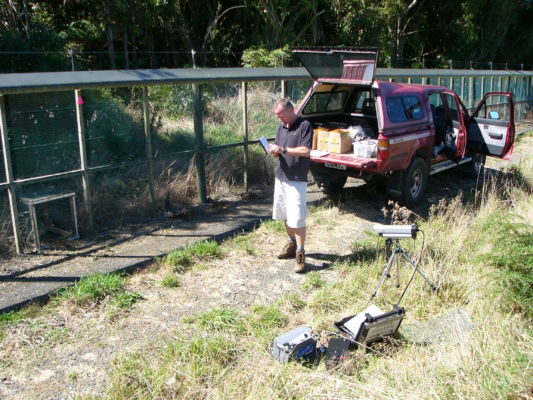Professor Carolyn (Kim) King has spent a lifetime studying New Zealand’s introduced mammalian predators and is recognised as an international expert on mustelids. She’s worked closely with weasels in England, and stoats, ferrets, and rats in New Zealand, since starting as a grad student at Oxford in 1967.

In that time she’s got to know their key attributes and survival strategies. She knows their strengths and she knows what can make them vulnerable.
Kim is a very strong supporter of the conservation work being done by community groups to help make New Zealand predator-free.
“I am 150% on the side of community groups! They are the only people who can make a difference on a large enough scale,” she says. “DoC can’t do it on their own.”

Kim is careful to emphasise, when talking about New Zealand’s predator-free aspirations, that it is misleading to say simply that “predator free New Zealand is impossible.”
“It is impossible now, but that does not mean it will be impossible in the future. The second part of the sentence is important,” Kim explains. “We don’t know what future technology will be. I’m all for a predator free future. We just can’t imagine technology different enough to do it. It’s like the difference between an electron microscope and a light microscope.”
Kim recalls a meeting she attended in 1976, not long after arriving in New Zealand from the UK, to work for the DSIR (Department of Scientific and Industrial Research).
“It was a ‘rats in nature reserves meeting’. All the experts present concluded that you can’t get rats off islands of more than 1 ha. Now we’re eradicating them from >11,000 ha. People back then couldn’t imagine the future technology, and we can’t imagine it either. The past doesn’t necessarily predict the future, so we don’t know what will be possible in 25 years time.”
In the meantime, Kim has good advice to offer community groups trying to make their own area predator free.
“You must pick battles you can win,” she says. “Protect an area that is defensible. Minimise reinvasion. Have a core area and a buffer zone.”
“Community groups are,” Kim emphasises, “doing a wonderful job! Anything done to prevent damage to birds during their breeding season is good, even if the pests come back later. It is always worthwhile.”
Becoming predator free is about more than just killing pests, as Kim explains.
“You need to ask a different question,” she says. “You need to ask ‘how many are left?’ and ‘how quickly can the population recover?’.”
Kim is also cautious about investing too much optimism initially, which then can’t be lived up to, resulting in people giving up and saying ‘it will never work’.
“We have to be judicious about (predator-free) expectations. It’s one step at a time, not all at once. Defensible areas, one at a time, learning from every step.”
Defensible areas can be peninsulas or islands, for example, where predators have limited pathways to reinvasion. Researchers are already testing how well those pathways – a narrow point joining a peninsula to the mainland or an island beach facing the mainland – can be defended against reinvasion once the resident predators are removed. Fenced sanctuaries also provide a defensible area – but erecting a pest-proof fence is only the beginning.

“Fences are wonderful,” Kim says, “but they’re very high maintenance.”
A few years back, one of her Masters students, Trevor Connolly, looked at how long it would take predators to reinvade a sanctuary if there was a breach in the fence. With the generous cooperation of Maungatautari Ecological Island Trust, who had just completed their predator-proof fence, Trevor cut holes in the brand new fence, placed secure cages behind the holes so that the sanctuary was not put at risk, and set up video cameras to monitor what happened.
“The results amazed everyone,” says Kim. “It was a nasty shock! If a tree falls on the fence and breaks it or a stream door sticks open, you have less than 24 hours to close the breach – in summer it’s much less than 24 hours. You need people on hand all the time.”
The research showed that the most likely invader would be a rat.
“All pests in the surrounding area spent a lot of time cruising the fence, attracted by the smells and sounds. The fence was under siege.”
A camera fixed to the hood of the sanctuary fence was also revealing.
“There’s a little gutter inside the hood where insects gather. Rats get inside the hood and cruise along looking for insects to eat.”
If the fence was to break, those rats would be immediately on hand to discover it.
Another issue with making a core defensible area pest-free is that some predators are untrappable. Stoats are particularly wary of traps and tunnels.
“On Secretary Island there is a hard core of untrappable adult female stoats,” says Kim. “Every year for 5-6 years DoC have tried, but they can’t get the last breeding female stoat off that island.”
She has some advice for community groups trying to remove elusive stoats.
“An individual will learn to avoid one thing,” she says. “You must try different things. Stoats are shy of tunnels and devices,” she explains, “and evolution is on their side.”
Those that survive through extreme caution may well be passing their cautious nature onto their offspring.
For stoats, however, 1080 can kill those device-shy individuals.
“A dying rat is irresistible to a stoat,” says Kim, “and eating the rat is natural behaviour.”
That explains why occasional 1080 operations can have a beneficial effect on kiwi breeding, even in areas where trapping has been happening for years. Even the most cautious of stoats can’t turn down the chance of an easy (poisoned) rat meal, although they probably wouldn’t take bait directly from a station themselves.
There are other possibilities for stoat control in the future.
“The most exciting potential development is CRISPR, a programme which in theory can allow editing of the genome of a species,” says Kim. “Stoats are very vulnerable in their reproductive cycle. They only have one litter per year. They have delayed implantation lasting 9-10 months. If we can interfere with that process, so that the female tries to implant the fertilised ova during the delay period, before the uterus is ready to receive them, then she will lose the the whole year’s production. She can’t mate again until the next spring – and may not live that long.”
Most stoats only live 1-2 years and may only have one chance to breed, although a few individuals may live 5-6 years, even up to 8 years in areas that are never trapped.
“We might be able to get rid of stoats,” says Kim. “There are only a few hundred thousand of them in most years. But rats – there are tens of millions of rats.”
In fact it is large populations of rats and mice that determine the number of stoats in an area.
“Stoats can’t survive long without mammalian prey,” Kim says. “Rats, mice, possums and rabbits provide the most meat in their diet. If you remove them, stoats will eat a lot of birds over the short term, but they can’t maintain a large population long-term only on birds.”
One example Kim gives, is when efforts were first made to save North Island kokako populations.
“All predators – including stoats – were targeted at first. Including stoats made a lot of extra work that wasn’t necessary,” says Kim. “They found that if they got rid of rats and possums it was enough to raise the breeding success of kokako. Kokako weren’t worried by stoats enough to justify targetting them as well.”
It’s a different story for kiwi. Their flightless young are very affected by stoats.
“Many arboreal birds in beech forests are killed after a good seedfall,” says Kim, “but not so many at other times. It’s not that individual stoats are each eating more birds in mast years. It’s because there are more stoats around, because there are more mice, and all those extra stoats are each eating the usual number of birds per head.”
So what advice can Kim give community groups when they do need to remove stoats?
“The Goodnature A24 self-resetting trap is the best available at the moment,” Kim believes.
Kim currently has a Masters student who is using the lure that Goodnature developed for the A24 in a camera setup to see what animals come to investigate. While the animal sniffs the bait, the camera takes its picture. The camera/bait set up is being used in native forest, pine forest and agricultural areas for comparison of what predators are present in each habitat. So far the lure is working well.
“It’s getting good results with rats, cats, ferrets weasels and stoats,” Kim says.
Research continues – it’s all about finding the best times of year to control predators effectively, better ways to attract mammalian predators to control devices, new ways to make them vulnerable, new ways to find out how many are left and how soon the reinvaders arrive…
“To remove a pest population altogether, every individual must be at risk and vulnerable,” Kim explains.
It’s one of the reasons that predator eradication is difficult in populated areas.
“You need every individual person to agree never to protect the pest animal, including on private property. Eradication is impossible if some individual animals are never at risk. If there are any refuges through human protection, behaviour (such as trap shyness) or reinvasion then eradication is impossible.”
To achieve a predator free New Zealand, we’re going to need a lot more innovation and EVERYONE on side. But what seems impossible now, may well be possible in the future.
“When it comes to predicting the future, experts are no better than anyone else,” says Kim, quoting Arthur C. Clarke. “We have to go beyond the limits of the possible…”

